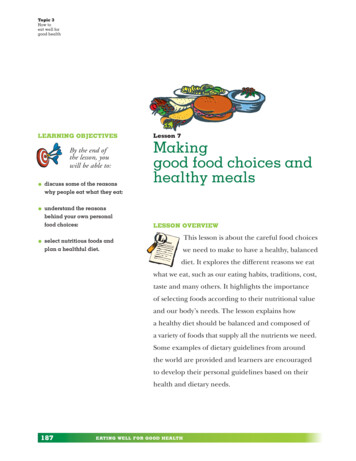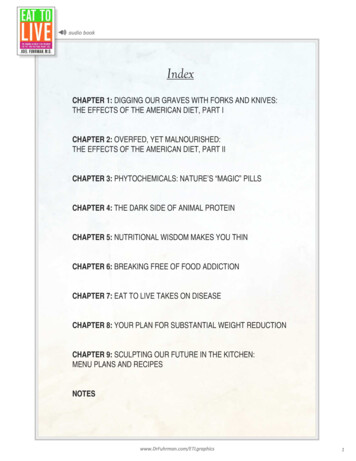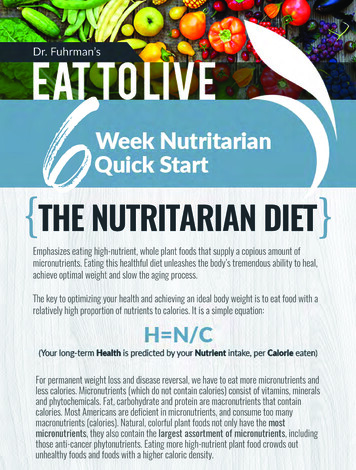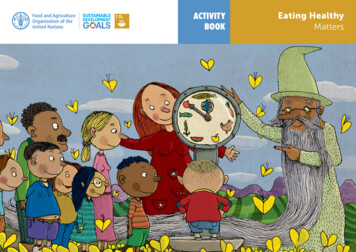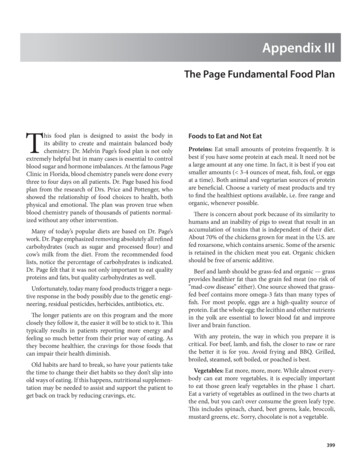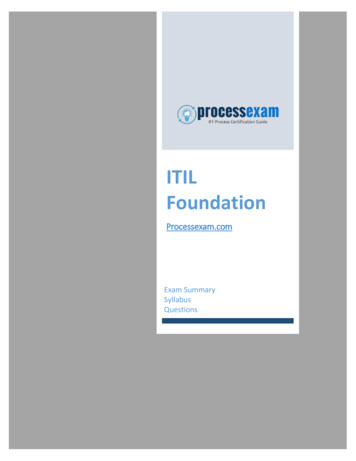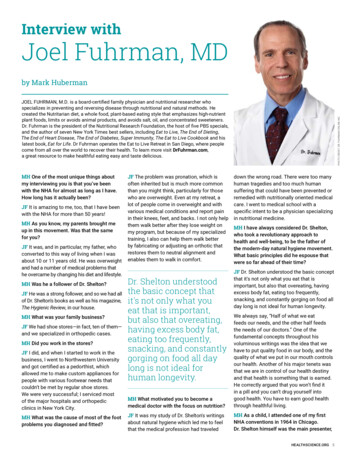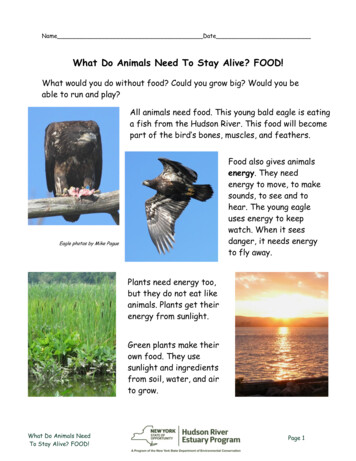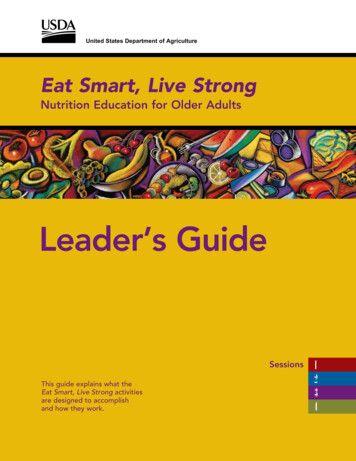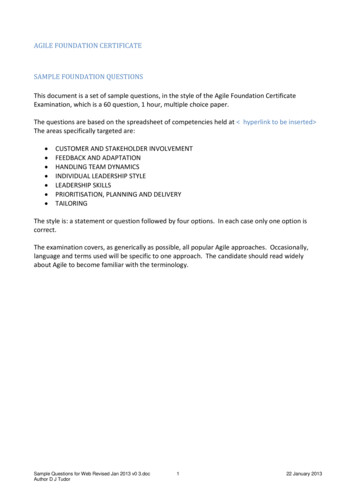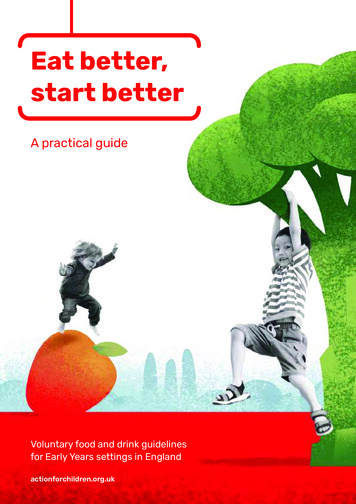
Transcription
Eat better,start betterA practical guideVoluntary food and drink guidelinesfor Early Years settings in Englandactionforchildren.org.uk
AcknowledgementsThis practical guide to the Voluntary Food and DrinkGuidelines for Early Years Settings in England was firstpublished in January 2012 and updated 2017.It was developed following the recommendationsof the Advisory Panel for Food and Nutrition inEarly Years, and was produced to support earlyyears settings in England to meet the nutritionalrequirements of children in their care, andencourage them to eat well.Action for Children would like to thank theChildren’s Food Trust and the members ofthe External Reference Group involved in thedevelopment of this practical guide. The sharingof their experience, expertise and providingtheir recipes provides an invaluable resourceto all Early Years providers to give children thefoundations for a healthy future.2Photos of children by Karla Gowlett, with thanksto Katharine Bruce Community Nursery, part ofthe London Early Years Foundation. Additionalphotos of children with thanks to NCMA (nowPACEY), NDNA and Pre-school Learning Alliance.Meals and snacks prepared and photographedby Helena Little (Brave Design) and Erica Hocking.Additional photos with kind permission fromthe Caroline Walker Trust.
Eat better, start better – A practical guideContentsForeword 4Section 04At a glance: Food and drink guidelinesfor each meal and snack 34Why healthy eating matters for young children 5Balancing lunch and tea 35Why has this guide been developed? 6Breakfast at a glance 36Who is this guide for? 6Mid-morning and mid-afternoon snacks at a glance 38Why is a healthy, balanced and nutritious diet essential for young children?7Lunch at a glance 40Tea at a glance 42What is the current health status of young children in England? 7What is a healthy, balanced, nutritious diet for children aged one to four years?7How does a healthy, balanced diet for children aged one to four years differ from that needed by older children and adults?8What about food and drink for children from birth up to 12 months old?8Section 01Section 05How to encourage children to eat well 44Developing a food policy and putting it into practice 45Communicating with children and families 45The eating environment and social aspects of meal times 46Breastfeeding 8Celebrations and special occasions 47Vitamin supplements and the Healthy Start scheme 9Providing food for all 48Nursery Milk Scheme 9Encouraging fussy eaters to eat well 51Physical activity 9Food brought in from home 52Learning about and through food 53Cooking with children 54Food safety and hygiene 55Section 02Planning menus 10Seven steps for planning healthy meals, snacks and drinks 11Section 03Sustainability 55Protecting children’s health – maintaining a healthy weight 55Providing food for infants aged six to 12 months 56The food and drink guidelines 12Understanding the food and drink guidelines 14How to use portion size information 14Summary of the four food groups 15Guidelines for potatoes, bread, rice, pasta and other starchy carbohydrates16Evaluating and showing others your approach to food and drink provision61Guidelines for fruit and vegetables 18Early Years Code of Practice for Food and Drink 62Guidelines for beans, pulses, fish, eggs, meat and other proteins 20Code of Practice Checklist 63Guidelines for dairy and alternatives 22Menu Planning Checklist 65Guidelines for desserts, puddings and cakes 24The nutrient framework 70Guidelines for drinks 26Example spring/summer menu, one to four year olds 73Guidelines for fat 27Example autumn/winter menu, one to four year olds 74Guidelines for salt 28Example spring/summer menu, infants seven to 12 months 75Guidelines for sugar 29Example autumn/winter menu, infants seven to 12 months 76How to read food labels 30Sizes of plates and bowls 77Iron and zinc 31Glossary 79Food additives 32Ready-made meals and take-aways 32Fortified foods 33Section 06Practical tools and resources:putting the guidelines into practice Section 07Where to find additional information 6082References 843
Action for Children supports parents, carers and anyoneworking with children by giving them the tools and guidancethey need to ensure that every child has the very best start inlife. We are seeing too many young children start schooloverweight which leads to long-term problems. This can beavoided with your help, and by using this practical guidedeveloped by the Children’s Food Trust which is an essentialresource for early years practitioners. Children need to acquiregood food habits early on that lay the foundations for a healthyfuture and this guide shows how.Tony Hawkhead, Chief Executive, Action for ChildrenWe were delighted that so many ofour members contributed some greatpractical tips and tools to help childreneat healthily. We very much welcomethese updated guidelines which willhelp ensure that all children have accessto the healthy, balanced diet they needto give them the best start in life.Liz Bayram,Chief Executive, Professional Associationfor Childcare and Early YearsAll children attending early years settingsshould benefit from a healthy, balancedand nutritious diet, and these voluntaryguidelines are an excellent resource tohelp to build practitioners’ knowledge,skills and confidence when cooking orpreparing food. With both the EYFS andOfsted’s Common Inspection Frameworkplacing a strong focus on children’snutrition, following these guidelines willhelp settings meet national standardsand demonstrate to parents a strongcommitment to helping children eat well.Neil Leitch, Chief Executive,Pre-school Learning AllianceWe welcome this updated guide andthe opportunities it provides for helpingchildren eat healthy and nutritious food.It is vital that we set a good foundationfor the health and wellbeing of all ourchildren.Ruth Pimentel, Director of Nurseries,Action for ChildrenThe update of the Children’s Food TrustVoluntary Food and Drink Guidelinesfor Early Years Settings in England:A Practical Guide supports the updatedGovernment advice in HM GovernmentMenus and Guidance for early yearssettings, providing helpful advice onhow to ensure food provision meetsthe nutritional needs of young children.We are passionate about reducinginequalities in childhood. The nationalfood and drink guidelines will helpto ensure that all young childrenhave access to a healthy, balanced,nutritious diet while attending earlyyears settings.Joyce Connor,Assistant Director Practiceand Programmes (Early Years),National Children’s BureauThe under-fives are a unique age groupin that their nutritional needs changequite rapidly, and guidance regardingfood groups and portion sizes is aparticular area of need. Nurseries arepassionate about helping children getthe best start in life, and this guidancewill help them do this consistentlythroughout their day-to-day practice.Claire Schofield,Director of Membership, Policyand Communications, National DayNurseries Association (NDNA)High quality early education boostschildren’s learning and can help tonarrow the gap between disadvantagedchildren and their peers. Providinghealthy food sets children up to learnand enjoy, which is why we supportthese guidelines and their role inimproving the quality of food providedby nurseries and childminders.Ellen Broomé,Chief Executive,Family and Childcare Trust.Eat Better, Start Better was supportedwith a grant under the Departmentfor Education’s ‘Improving Outcomesfor Children, Young People andFamilies’ fund.Dr Alison Tedstone, Chief Nutritionist,Public Health EnglandWith special mention to the Children’s Food Trust for the development of this guide.4
01Eat better, start better – A practical guideWhy healthy eating mattersfor young children PageWhy has this guide been developed? 6Who is this guide for? 6Why is a healthy, balanced andnutritious diet essential foryoung children? 7What is the current health statusof young children in England? 7What is a healthy, balanced,nutritious diet for children agedone to four years? 7How does a healthy, balanced dietfor children aged one to four yearsdiffer from that needed by olderchildren and adults? 8What about food and drink forchildren from birth up to12 months old? 8Breastfeeding 8Vitamin supplements and theHealthy Start scheme 9Nursery Milk Scheme 9Physical activity 95
01Why healthy eating matters for young childrenWhy has this guidebeen developed?This guide has been developed to help early yearsproviders and practitioners to meet the Early YearsFoundation Stage (EYFS) welfare requirement for theprovision of healthy, balanced and nutritious foodand drink.1 Encouraging children to eat well and learnabout food in their early years not only protects theirhealth when they are young, but also sets thefoundations for their future health and wellbeing.This guide is for early years settings providingmeals, snacks or drinks to children from the ageof one up to four years.† The new example earlyyears menus cover food provision for childrenaged six months to four years and information onproviding food for infants aged six to 12 monthshas been included on pages 56-59.This guide can be used by all regulated providers,regardless of the length of time that childrenspend in the setting, including: children’s centres registered childminders and nannies private, voluntary and independent nurseries local authority maintained nursery schoolsEarly yearssettings provide anideal opportunity tohelp every child eat well,enjoy a varied dietand establish healthyeating habits to takewith them into theirschool years.This guide setsout the food and drinkguidelines for early yearssettings in England.Following the advice inthis practical guide whenproviding food and drinkwill help you to meetthe nutritionalrequirements ofyoung children inyour care.6Who is this guide for?Early years settings provide an ideal opportunityto help every child eat well, enjoy a varied dietand establish healthy eating habits to take withthem into their school years. nursery classes within primary schools‡Early years providers, practitioners and parentshave called for clear, national guidelines on whatchildren under the age of five should eat anddrink while attending early years settings.2Non-regulated settings, such as parent andtoddler groups, are also encouraged to use thisguide when planning and providing food anddrink for children.This guide sets out the food and drink guidelinesfor early years settings in England, and wasupdated in 2017 to reflect current governmentdietary recommendations for infants and childrenaged six months to four years. Following theadvice in this practical guide when providingfood and drink will help you to meet thenutritional requirements of young childrenin your care.Parents and carers may find this guide useful tohelp them to understand the types and amountsof food and drink that they should expect theirchild to be offered whilst attending an early yearssetting. Involving parents and their children infood and drink provision is an important aspectof the Early Years Foundation Stage3 framework,as it helps to reinforce good eating habits for life. pre-schools sessional settings, such as playgroups.
Eat better, start better – A practical guideWhat is the currenthealth status of youngchildren in England? Over a fifth of children are either overweightor obese by the time they join receptionclass in primary school (their final year inthe EYFS).8 Type II diabetes, which usually appears inadulthood, is starting to be seen amongsome overweight children.9Why is a healthy,balanced and nutritiousdiet essential foryoung children?A healthy, balanced diet and regular physicalactivity are essential for children’s health andwellbeing. Research confirms that healthyeating habits in the years before school arevery important because they influence a rangeof health and development outcomes inlater life.4, 5, 6A 2010 review of health inequalities byMarmot7 identifies the early years as a crucialtime to intervene to reduce health inequalitiesacross the life course. Quality of early yearsexperiences can have a fundamental impacton all aspects of human development,physically, emotionally and intellectually.Encouraging breastfeeding and ensuring thatchildren eat well in their early years are key toensuring that they achieve their potential, andhelp prevent them becoming overweight andobese. This approach also helps to reduce therisk of serious diseases such as heart disease,diabetes, stroke and cancers in later life.Good nutrition is important for children agedunder five to: Dental health is poor in many youngchildren.10 Cases of rickets are appearing morefrequently.11 More than one in four young children in theUK may be at risk of iron deficiency,12 whichis linked to slower intellectual developmentand poor behaviour in the longer term.13In recent years, changes in children’s dietshave affected their nutrient intakes with somechildren eating foods that are low in energy,iron and vitamin A, and high in saturated fat,sugars14 and salt.15 In addition, many youngchildren also eat fewer than the recommendedfive portions of fruit and vegetables each day.16What is a healthy,balanced, nutritious dietfor children aged one tofour years?A healthy balanced diet for children aged oneto four years is based on the four food groupslisted below, which provide a range of essentialnutrients that children need to grow anddevelop. ensure that they get the right amount ofenergy (calories) and nutrients needed whilethey are growing rapidlyPotatoes, bread, rice, pasta and otherstarchy carbohydrates ensure that they do not consume too muchenergy (calories), which may lead to childrenbecoming overweight or obeseBeans, pulses, fish, eggs, meatand other proteins encourage them to eat a wide variety offoods and develop good dietary habits totake with them into later childhood andbeyond.† This guidance has been written to ensure the nutritional requirements ofchildren aged from one up to four years are met. These requirements havebeen derived from the Dietary Reference Values (DRVs) for children aged oneto four years. This includes children up to their fifth birthday.‡ The food and drink guidelines within this guide apply only to nursery classeswithin primary schools. Food and drink provided to registered pupils at localauthority maintained primary schools is required to meet The Requirementsfor School Food Regulations 2014. Food provided to children attendingnursery units of primary schools is required to meet schedule 5 of theseregulations; meeting the food and drink guidelines in this document willmeet these requirements.Fruit and vegetablesDairy and alternativesOne of the basic principles of healthy eatingis variety, as eating a wider range of differentfoods provides a better balance of nutrients.Planning meals and snacks to include a varietyof food and drinks from these four food groupseach day will provide children with the goodbalance of nutrients they need.The wider thevariety of food anddrinks eaten, thebetter the balanceof nutrientsprovided.Foods and drinkshigh in fat, saltand sugarsYoung children need fat in theirdiet to ensure they get enoughenergy. However, if they eat toomuch fat, they may consume moreenergy (calories) than they need,and may gain excess weight. Thetype of fat that children eat is alsoimportant, and the amount ofsaturated fat, found in foods suchas meat and meat products,butter, cakes and biscuits,should be limited.It is also important that children donot eat too much sugar and salt.Eating sugary food and drinks toooften can lead to tooth decay andprovide ‘empty calories’ which fillchildren up but do not provideother essential nutrients. Too muchsalt can give children a taste forsalty foods, and eating a diet highin salt can cause serious healthconditions in later life.To establish good eating habits,make sure the food and drinkyou provide for children is nothigh in saturated fat, sugar and salt.Limiting or avoiding some foods,ingredients and cooking practiceswill help to ensure that anappropriate amount of fat, sugarand salt is provided for children,and will also help encouragediversity in children’s diets. Foods,ingredients and cooking practicesto limit or avoid are highlighted inthe food and drink guidelines.Children are unlikely to take inmore energy than they need ifthey are offered a range of healthymeals and snacks that meet thefood and drink guidelines.Conversely, foods that are high infat, sugar and salt are unlikely toprovide the balance of energyand nutrients that young childrenneed and including them in thediets of very young children maycontribute to them becomingoverweight and having a poornutrient intake.Further guidance on fat, salt andsugar can be found on pages 27–29.7
01Why healthy eating matters for young childrenHow does a healthy,balanced diet for childrenaged one to four yearsdiffer from that neededby older children andadults?Healthy eating advice for children aged five andover and for adults is illustrated by the EatwellGuide,17 which shows the proportions in whichdifferent types of foods are needed to have awell-balanced and healthy diet.Young children are growing quickly and havehigh energy and nutrient requirements for theirsize. They also eat smaller amounts than olderchildren and adults, so it is important for themto eat regular meals and snacks that containsufficient energy and nutrients for their needs.A low-fat, high fibre diet based on theproportions set out by the Eatwell Guide istherefore not appropriate for young children,particularly children aged under two years, asit may not provide enough energy, fat, iron orzinc, and is too high in fibre.Between the ages of two and five years,children should gradually move towards thediet recommended for older children andadults, with less energy provided from fat,and more fibre.Young children aregrowing quicklyand have highenergy and nutrientrequirements fortheir size.What about food anddrink for childrenfrom birth up to 12months old?In the first 12 months of life, babies’ nutritionalrequirements differ from those of children agedover one year. Information on introducing avariety of foods and encouraging infants to eatwell can be found on pages 56-59. Two exampleone week menus showing how meals for oneto four year olds can be adapted for infants agedseven to 12 months can be found on pages75 and 76. More detailed guidance on how toprovide food and drink for this age group isavailable from HM Government (2017) ‘Examplemenus for early years settings in England:Part 1 - Guidance’.18For more information on providing healthy foodand drink to children from birth up to 12 monthsrefer to the Start4life website and resources,19 theNHS Choices website,20 or the First Steps NutritionTrust ‘Eating well: the first year’.21BreastfeedingEncouraging breastfeeding is a priority.Exclusive breastfeeding is recommended foraround the first six months of a baby’s life and,after that, giving breast milk alongside solidfood will help them to continue to grow anddevelop.19 Breastfeeding has long-term benefitsfor babies. Not breastfeeding can increase therisk of gastrointestinal, respiratory and middleear infections. There is also an associationbetween not breastfeeding and risk of suddeninfant death syndrome (SIDS), and growingevidence that not breastfeeding may increasethe risk of overweight/obesity and diabeteslater in life. Breastfeeding also has benefits forthe mother, with good evidence to suggest thatbreastfeeding decreases the risk of breast cancerand may also reduce the risk of ovarian cancerand type 2 diabetes.19, 22, 23Mothers who return to work but wish to continueto breastfeed should be encouraged and enabledto do so.23 Expressed breast milk provided forbabies in early years settings should be labelled,stored safely and used only for that child. Moredetailed guidance on supporting women tobreastfeed in early years settings, safe storageof expressed breastmilk and infant formula isavailable in HM Government (2017) ‘Examplemenus for early years settings in England: Part1 - Guidance’.18Advice on expressing and storing breast milkcan be obtained from a health visitor or onlinefrom NHS choices24 or the Association forBreastfeeding Mothers.258
Eat better, start better – A practical guideVitamin supplements andthe Healthy Start schemeGovernment recommends: Breastfed babies from birth to one year of ageshould be given a daily supplement containing8.5 to 10µg of vitamin D, to make sure they getenough Babies fed infant formula should not be given avitamin D supplement until they are receivingless than 500ml (about a pint) of infant formulaa day, because infant formula is fortified withvitamin D Children aged one to four years old should begiven a daily supplement containing 10µg ofvitamin D.In addition, government recommends thatchildren aged from six months to five years aregiven daily vitamin supplements containingvitamins A (233µg) and C (20mg). This is aprecautionary measure, to ensure that theirrequirements for these nutrients are met, at atime when it is difficult to be certain that thediet provides a reliable source. More details areavailable on the NHS choices website.26In 2006, the Healthy Start Scheme27 replaced theWelfare Food Scheme. Families receiving HealthyStart vouchers can use them to purchase plaincows’ milk, fresh or frozen fruit and vegetables,or infant formula suitable from birth. Thescheme also provides free Healthy Start vitaminsupplements for pregnant women and womenwith a child aged under 12 months. Childrenreceiving Healthy Start vouchers qualify for freechildren’s vitamin drops containing vitamins A,C and D from aged six months until theirfourth birthday.Nursery Milk SchemeThe Nursery Milk Scheme enables registered earlyyears settings to claim reimbursement for thecost of a third of a pint (189ml) or, where suppliedin 200ml containers only, with 200ml of milk foreach child aged under five years who attends fortwo or more hours a day. For more information,visit the Nursery Milk Scheme website.28Physical activityRegular physical activity during the early yearsprovides immediate and long-term benefits forphysical and psychological wellbeing. Physicalactivity has very low risks for most under fives,whereas the risk that childhood inactivity willlead to poor health in later life is high.29 Allchildren aged under five years should minimisethe amount of time spent being sedentary(being restrained or sitting) for extendedperiods (except time spent sleeping).All children underfive should minimisetime spent beingsedentary.Physical activity includes all forms of activity, suchas walking, active play and active games. Childrenare more likely to maintain a healthy weight ifthey are physically active for at least 180 minutes(three hours) each day, as recommended forchildren aged under five years in the UK.29The scheme aims to engage with parentsfrom early pregnancy to ensure that they areprovided with information on healthy eatingand the appropriate use of vitamin supplementsfor children. It is the responsibility of parentsto administer these supplements. Early yearssettings can, however, encourage parents whoare eligible, to apply for vouchers to help payfor food provided at home.9
02Planning Menus702Planningmenus6Seven steps forplanning healthy meals,snacks and drinks432110
Eat better, start better – A practical guideIt is important that the food and drink provided for children is balancedacross each day, and that children eat regularly, with breakfast, lunch, tea,and two or three snacks provided daily (either within an early years settingor at home). Using these food and drink guidelines to plan meals andsnacks for children will help to make sure that all children eat a healthy,balanced diet, whether they attend full-day care in one setting, or attendseveral settings throughout the week.STEP 1. Plan menus for all the meals and snacks you provide for children.The Children’sHouse Nurseryuses a 12 day menucycle, which meansthat childrenattending on one ortwo days a weekreceive a widevariety of differentmeals.This will help you to check that food and drink provision across the day is balancedand includes variety, and also helps planning for shopping and food preparation.STEP 2. Step 2. Plan menus lasting at least one week.In practice, a menu that covers between one and four weeks will give children lotsof variety. Try to make sure that children who attend your setting on the same dayeach week are not always provided with the same meal.STEP 3.STEP 4.Plan each meal and snack menu tomeet the food and drink guidelinesin this guide.Plan menus to include a varietyof foods, tastes, textures and colours.This means that children attending yoursetting for sessional care or who movebetween different settings will still meettheir nutritional requirements overall.ChildminderSandra Cook foundthat introducing arolling three weekmenu instead ofplanning menuseach week savesher time.This will give children opportunity to trya wide range of foods, and make mealsand snacks colourful and tasty.STEP 5.STEP 6.Introduce new menu cycles at leasttwice a year.This will incorporate seasonality and givechildren the chance to try different foods.Make sure you cater for the culturaland dietary needs of all the childrenin your care.You can also plan your menus to enablechildren to experience food from differentcultures. You will find more informationabout this on page 50.STEP 7. Share menus for meals and snacks with parentsThis can help parents to balance meals and snacks with the food they provide athome. For example, if children are having a light meal at teatime and you expectthem to eat again at home, make sure that parents are aware of this.Practical tools for menu planningIn section 6, you will find practical tools to help you plan menus for meals and snacks, including:a menu planning checklist to evaluate menus against the food and drink guidelinesexample spring/summer and autumn/winter menus meeting the food and drink guidelines.11
03The food and drink guidelines03The food and drinkguidelines 12Page PageUnderstanding the food and drink guidelines 14Guidelines for fat 27How to use portion size information 14Guidelines for salt 28Summary of the four food groups 15Guidelines for sugar 29Guidelines for potatoes, bread, rice, pastaand other starchy carbohydrates 16How to read food labels 30Guidelines for fruit and vegetables 18Iron and zinc 31Food additives 32Guidelines for beans, pulses, fish, eggs,meat and other proteins 20Ready-made meals and take-aways 32Guidelines for dairy and alternatives 22Fortified foods 33Guidelines for desserts, puddings and cakes 24Guidelines for drinks 26
Eat better, start better – A practical guideThe food and drink guidelines in this section describe how often, howmuch, and which types of food from each of the four food groups shouldbe provided for children aged one to four years.* Following these guidelineswill help to make sure that the food and drink you provide is healthy,balanced and nutritious.The food and drink guidelines are underpinnedby a nutrient framework, which includes energyand key nutrients: protein, fat, carbohydrate,dietary fibre, free sugars, vitamin A, vitamin C,iron, zinc, calcium and sodium. Providing thetypes and amounts of food and drink outlinedby the guidelines will ensure children receiveappropriate amounts of energy and thesenutrients. For further information about thenutrient framework, see page 70.Use the guidelines to plan which food anddrinks to provide as part of meals and snacks forchildren in your care.The food and drink guidelines are also listed foreach separate meal (breakfast, lunch and tea) andsnack in section 4 (page 34). This information canbe used to check that the guidelines are met foreach mealtime.Information included in this section explains: The types of food and drink included ineach food group. This will help you to choosea variety of food and drinks for children’s mealsand snacks. Why each food group is important.This outlines the key nutrients each food groupprovides and explains their importance forchildren’s health. Guidelines for planning menus. Theseoutline how frequently to provide foods fromeach food group, how to limit saturated fat, saltand sugar, and food safety considerations. Typical portion sizes for children aged oneto four years.* Portion sizes are based on theenergy and nutrient requirements of childrenaged one to four years. In order to ensure thatthe energy and nutrient needs of those in thegroup with the highest requirements are met,these are based on estimated average energyrequirements for children aged three to fouryears, and for other nutrients, on the highestrequirements within the one to four year agerange. This means that the typical portionsizes will be appropriate for children with thehighest requirements (generally children agedthree to four years), and smaller portion sizesmay be appropriate for children younger thanthis (children one to two years old).Providing the typesand amounts of foodand drink outlinedby the guidelineswill ensure childrenreceive appropriateamounts of energyand nutrients.However, remember that children’s requirementsfor growth and activity, and their appetites willvary; they should be encouraged to eat healthyfood according to their appetite.* Portion sizes are typical example portion sizes for children aged one to four years and are not suitable for children under the age of one year.13
03The food and drink guidelinesUnderstanding thefood and drinkguidelinesHow to use portion sizeinformationSmallbowl8cmThe nutrient content of food and drinkprovided for children depends on the portionsize of the food and drink that is offered.The food and drink guidelines in this sectioninclude examples of typical portion sizes ofdifferent food and drink for children aged oneto four years.** The typical portion sizes givenare for
their recipes provides an invaluable resource . good food habits early on that lay the foundations for a healthy future and this guide shows how. . Why healthy eating matters for young children 01 5 Eat better, start better

